gold rush
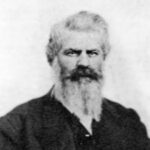 Politics can be a touchy subject. Many arguments have come from political disagreements, and in fact, a number of actual fights and even wars have been fought over political disagreements. The Civil War was one sch war fought over political views. During that time there were also a number of private disputes as well. Sumner Pinkham was in volved on one of those disputes. Sumner Pinkham was born in 1820 in the state of Maine and was raised in Wisconsin. Very little, if anything, is known about his early life. He married Laurinda Maria Atwood in Nebraska on November 4, 1842. In 1849, Pinkham joined the California gold rush and then spent time in Oregon before making his way to the booming gold rush camp of Idaho City in 1862. Pinkham was a big man…powerfully built, who stood six feet two inches tall and had a barrel chest. He was also prematurely gray, making him look older than he really was.
Politics can be a touchy subject. Many arguments have come from political disagreements, and in fact, a number of actual fights and even wars have been fought over political disagreements. The Civil War was one sch war fought over political views. During that time there were also a number of private disputes as well. Sumner Pinkham was in volved on one of those disputes. Sumner Pinkham was born in 1820 in the state of Maine and was raised in Wisconsin. Very little, if anything, is known about his early life. He married Laurinda Maria Atwood in Nebraska on November 4, 1842. In 1849, Pinkham joined the California gold rush and then spent time in Oregon before making his way to the booming gold rush camp of Idaho City in 1862. Pinkham was a big man…powerfully built, who stood six feet two inches tall and had a barrel chest. He was also prematurely gray, making him look older than he really was.
Pinkham was a conservative Republican, a Unionist, and an abolitionist, which put him on the opposite side of the majority of Boise Basin mining camps political views, which were predominantly Democrat. When Pinkham arrived in the Idaho City area, Idaho was still a part of Washington Territory, and the Boise Basin was located in Idaho County, of which Florence was the county seat. Florence was located a way away from the new mining basin, so the Washington Legislature established Boise County on January 29, 1863.
After being in the area for a while, and becoming known for his political views, the Governor of Washington was assigning commissioners and officers to the newly established county, and Pinkham was one of them, assigned to serve as the County Sheriff. On March 4, 1863, Congress created Idaho Territory. At that time Boise County exceeded the other counties in both area and in population. Those in office in Boise County at the time, including Pinkham, retained their positions until the territorial government could be officially organized. Pinkham appointed Orlando “Rube” Robbins, who shared his political opinions, as his deputy in August 1863. Robbins would later make himself known as one of Idaho’s greatest lawmen.
By this time, the Civil War was raging back East, and the area miners began to choose sides, around the Union and Confederate causes. This, dueled with whiskey, caused flair-ups between North and South sympathizers, bring with it fist fights, knife fights, and sometimes gun battles as they used force to show their opinions. That kept both Pinkham and his deputy, Rube Robbins, busy breaking up fights and locking up drunken loudmouths as they threatened to fight it out…to the death. The area being predominately Democrat often placed Pinkham at odds with his constituents due to his staunch Unionist views, Republican politics, and tough law enforcement. His list of enemies grew. Nevertheless, both Pinkham’s enemies and his most loyal friends knew that he was a man they shouldn’t mess with when he undertook to enforce the law, which he did with an iron hand.
His greatest enemy was a Southern gunfighter named Ferdinand “Ferd” Patterson. On one occasion, while Patterson was partying with some of his friends in Idaho City, they took unlawful possession of a brewery in Idaho City. Sheriff Pinkham was called by the owner to remove the rowdy group. When Pinkham entered the brewery, he was met with violent resistance. Pinkham and Patterson immediately hated each other. Patterson was Southerner who was crooked by nature, and Pinkham was a Northerner who tended to be self-righteous. In the end, Pinkham was successful, and Patterson was arrested. When Pinkham lost his October 1864 for re-election as Boise County Sheriff, in a bitter contest between the Democratic successionists and Republican candidates. Pinkham was defeated by A O Bowen by a comfortable majority, and Patterson celebrated, as the last of the ballots were being counted. When Patterson encountered his old nemesis, he began rubbing it in. Pinkham, who was in a rage, swung at Patterson, hitting him in the jaw and throwing the gambler off the street and into the gutter. After that, Pinkham walked away. Everyone expected Patterson to retaliate, but he let it go…for then. Pinkham left Idaho City, following the lost election, heading to Illinois to visit his dying mother. When he returned in 1865, everyone figured they would have it out, but it didn’t happen then either.
After the Civil War ended, Pinkham held a huge Fourth of July party. The crowds were mostly festive, with fireworks blazing and booze abundant. The celebration included a brass band, speeches, patriotic songs, a picnic, and a parade with Pinkham leading the way through town. For the victorious Yankees, it was a proud day. But, for the sullen Confederate sympathizers…not so much. To make matters worse, the Yankee’s heckled the “Blue Bellies” throughout the day. Patterson was furious as he watched Pinkham leading the parade through town. Pinkham singing, “Oh, we’ll hang Jeff Davis to a sour apple tree!” was the last straw. Patterson yelled out to the ex-sheriff that if “he didn’t shut his mouth, he’d shut it for him.” Pinkham invited him to try, and he did. A brief fist fight between the two men resulted in the flag falling into the dust of the street. Some witnesses swore they saw Patterson spit on it, and others attested they heard Pinkham swear he would kill Patterson for that, but nothing more came of it at that time. Several weeks later, on Sunday, July 23rd, Pinkham took a hired carriage from Idaho City to the Warm Springs Resort, which was about two miles west of town. Upon his arrival, Pinkham joined a number of his Unionist friends in the saloon, where they were heard singing patriotic and anti-Confederate songs.
Sometime later, Patterson entered the resort while Pinkham was paying his bill. Initially, Patterson ignored Pinkham, but by the time the ex-sheriff exited the resort, Patterson was outside waiting for him. Patterson said the word “draw” and then taunted Pinkham by calling him an “Abolitionist son-of-a-b***h.” Who drew first is in dispute, but in the end, Pinkham was dead. Patterson quickly fled but was immediately followed by several lawmen. Rube Robbins was the first to catch up to him, about 14 miles from Idaho City. Patterson surrendered to Robbins, who turned the killer over to Sheriff Bowen, who was next on the scene. Bowen and his men took over and escorted Patterson back to Idaho City.
A mob wanted to lynch him, and maybe that would have been justice, because in the “sham” trial held in a predominately Democrat area, Patterson was acquitted, and with that, justice for Pinkham would never be served. Ferd Patterson was tried for Pinkman’s murder at the beginning of November 1865. In the six-day trial, defense attorney Frank Ganahl claimed his client acted in self-defense, arguing that Pinkham was lying in wait 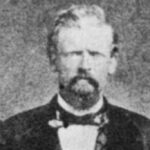 for him. Alternatively, Pinkham’s friends testified that he tried to avoid a showdown and that Patterson came to Warm Springs with the explicit purpose of murdering Pinkham. It took only an hour and a half for the jury to acquit Patterson. Pinkham’s funeral was the largest and most impressive funeral ever seen in the mining camp. It was reported that over 1,500 mourners followed his hearse to the graveyard. Meanwhile, knowing he was in extreme danger, Patterson quickly fled Idaho City after his acquittal. He was killed in Walla Walla, Washington, the next year, by Thomas Donahue, an area policeman, in was thought by many to be an assassination. Donahue was charged with the murder of Patterson, but escaped from jail while awaiting trial. There apparently was little interest in tracking him down. He disappeared never to be heard from again.
for him. Alternatively, Pinkham’s friends testified that he tried to avoid a showdown and that Patterson came to Warm Springs with the explicit purpose of murdering Pinkham. It took only an hour and a half for the jury to acquit Patterson. Pinkham’s funeral was the largest and most impressive funeral ever seen in the mining camp. It was reported that over 1,500 mourners followed his hearse to the graveyard. Meanwhile, knowing he was in extreme danger, Patterson quickly fled Idaho City after his acquittal. He was killed in Walla Walla, Washington, the next year, by Thomas Donahue, an area policeman, in was thought by many to be an assassination. Donahue was charged with the murder of Patterson, but escaped from jail while awaiting trial. There apparently was little interest in tracking him down. He disappeared never to be heard from again.
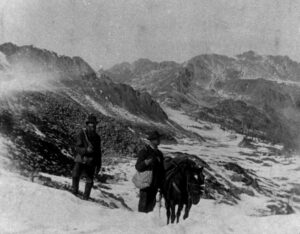 When we think of the Gold Rush years, most of us think of California, but in reality, not every big strike was in California. One of the greatest gold rushes of North America occurred in the Pike’s Peak area. Known as the Pike’s Peak Gold Rush, it was also called the Colorado Gold Rush. The Pike’s Peak Gold Rush a boom in gold prospecting and mining in the Pike’s Peak area of what was then the western Kansas Territory and southwestern Nebraska Territory of the United States. Now it is located in Colorado, of course. The rush began in July 1858 and lasted until just about the time of the creation of the Colorado Territory on February 28, 1861. The rush brought an estimated 100,000 gold seekers, called the Fifty-Niners to the Pike’s Peak area. It was part of one of the greatest gold rushes in North American history.
When we think of the Gold Rush years, most of us think of California, but in reality, not every big strike was in California. One of the greatest gold rushes of North America occurred in the Pike’s Peak area. Known as the Pike’s Peak Gold Rush, it was also called the Colorado Gold Rush. The Pike’s Peak Gold Rush a boom in gold prospecting and mining in the Pike’s Peak area of what was then the western Kansas Territory and southwestern Nebraska Territory of the United States. Now it is located in Colorado, of course. The rush began in July 1858 and lasted until just about the time of the creation of the Colorado Territory on February 28, 1861. The rush brought an estimated 100,000 gold seekers, called the Fifty-Niners to the Pike’s Peak area. It was part of one of the greatest gold rushes in North American history.
The peak year for the gold rush was 1859, and so after that year, the miners were called Fifty-Niners. The miners often used the motto “Pike’s Peak or Bust!” Actually, the location of the Pike’s Peak Gold Rush was centered 85 miles north of Pike’s Peak, but because of the well-known mountain, and its visibility from a long way off, the name of the peak became the name of the rush. The Pike’s Peak Gold Rush, began about a decade after the California Gold Rush, and produced a dramatic, albeit temporary influx of migrants and immigrants into the Pike’s Peak Country of the Southern Rocky Mountains. When the rush ended many of them moved on to other placed in search o the next big rush. The prospectors provided the first major European-American population in the region. The rush brought with it a few mining camps such as Denver City and Boulder City that would actually develop into cities that still exist today. Many smaller camps such as Auraria and Saint Charles City were among those that were later absorbed by larger camps and towns. Still others, faded into ghost towns, but quite a few camps such as Central City, Black Hawk, Georgetown, and Idaho Springs survived.
The discovery of gold in the Pike’s Peak area wasn’t a surprise to everyone. In 1835, French trapper Eustace Carriere lost his party and ended up wandering through the mountains for many weeks. During those weeks he 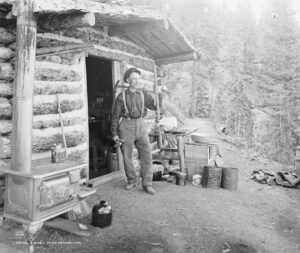 found many gold specimens which he later took back to New Mexico for examination. I suppose it was worth being lost, but while the specimens turned out to be “pure gold” he was unable to locate the area on an expedition he led to go back and look for it. He just couldn’t quite remember the location. Also, in 1849 and 1850, several parties of gold seekers bound for the California Gold Rush panned small amounts of gold from various streams in the South Platte River valley at the foot of the Rocky Mountains. They decided that they weren’t really impressed with the Rocky Mountain gold, so they moved on to California, possibly cheating themselves out of a great find, had the persevered.
found many gold specimens which he later took back to New Mexico for examination. I suppose it was worth being lost, but while the specimens turned out to be “pure gold” he was unable to locate the area on an expedition he led to go back and look for it. He just couldn’t quite remember the location. Also, in 1849 and 1850, several parties of gold seekers bound for the California Gold Rush panned small amounts of gold from various streams in the South Platte River valley at the foot of the Rocky Mountains. They decided that they weren’t really impressed with the Rocky Mountain gold, so they moved on to California, possibly cheating themselves out of a great find, had the persevered.
When the California Gold Rush began to die out, many discouraged gold seekers started to return home. Still, they weren’t really wanting to go home empty-handed, and they has heard the rumors of gold in the Pike’s Peak area. So, they tried their luck again, and their hard work paid off. In the summer of 1857, a party of Spanish-speaking gold seekers from New Mexico worked a placer deposit along the South Platte River about 5 miles above Cherry Creek, now part of metropolitan Denver.
William Greeneberry “Green” Russell was a Georgian man who had worked in the California gold fields in the 1850s. He was married to a Cherokee woman, and through his connections to the tribe, he heard about an 1849 discovery of gold along the South Platte River. Much encouraged, he organized a party to prospect along the South Platte River. He set out with his two brothers and six companions in February 1858. They met up with Cherokee tribe members along the Arkansas River in present-day Oklahoma and continued westward along the Santa Fe Trail. Others joined the party along the way until their number reached 107 people.
When you have spent any time in Colorado, the names of the places where gold was found are very real to you. Places like Cherry Creek, Denver, Confluence Park in Denver, Englewood, and a number of others stand out to you. The group finally found a small amount of 20 troy ounces in the Englewood area. Their excitement grew…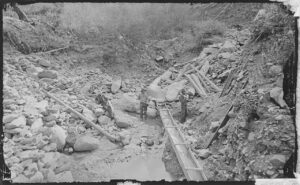 and so the boom began. The first decade of the boom was largely concentrated along the South Platte River at the base of the Rocky Mountains, in the canyon of Clear Creek in the mountains west of Golden City, at Breckenridge and in South Park at Como, Fairplay, and Alma. The towns of Denver City, Golden City, and Boulder City were substantial towns that served the mines in 1860. It was the rapid population growth of the Pike’s Peak Gold Rush that led to the creation of the Colorado Territory in 1861. Unfortunately, the rush, like all gold rushes, faded and while Colorado is still a fairly large population area, it isn’t what it might have been had the gold rush continued.
and so the boom began. The first decade of the boom was largely concentrated along the South Platte River at the base of the Rocky Mountains, in the canyon of Clear Creek in the mountains west of Golden City, at Breckenridge and in South Park at Como, Fairplay, and Alma. The towns of Denver City, Golden City, and Boulder City were substantial towns that served the mines in 1860. It was the rapid population growth of the Pike’s Peak Gold Rush that led to the creation of the Colorado Territory in 1861. Unfortunately, the rush, like all gold rushes, faded and while Colorado is still a fairly large population area, it isn’t what it might have been had the gold rush continued.

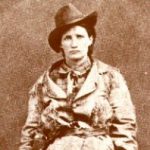 The Gold Rush affected many states and many people. Everyone headed west to try their luck, hoping to strike it rich. While the big strikes seemed to be in California, the Black Hills, and Alaska, there were many other places where miners struck it rich…and just as many where the miners went bust. It takes a special group of people to persevere in the gold rush years, and many went home broke, or found another way to cash in on the god rush, such as stores where the miners could buy supplies, or saloons, where they could drown their sorrows.
The Gold Rush affected many states and many people. Everyone headed west to try their luck, hoping to strike it rich. While the big strikes seemed to be in California, the Black Hills, and Alaska, there were many other places where miners struck it rich…and just as many where the miners went bust. It takes a special group of people to persevere in the gold rush years, and many went home broke, or found another way to cash in on the god rush, such as stores where the miners could buy supplies, or saloons, where they could drown their sorrows.
Wyoming had it’s share of gold mines and gold strikes too. Atlantic City was located in west central Wyoming, it was one of three mining towns in the area. The others were South Pass City, and Hamilton City. These towns sprung up as a result of the gold discovery at Spring Gulch in 1867. Hamilton City is located about three miles east of Atlantic City, but it could prove very difficult to locate, because early on in the town’s history, the townspeople unofficially renamed it to Miners Delight after the area’s largest and most productive mine, which carried the same name and was located on Peabody Hill.
The Miners Delight mine was founded by Jonathan Pugh. After a while, the town was officially changed to Miners Delight, since no one called it Hamilton City anyway. At first the mine was a rich enough producing mine to warrant a 10-stamp mill to be erected to crush the rock. The first mention of the town in newspapers appeared in July 1868 with the Sweetwater Mines newspaper describing it as: “…some thirty buildings are up, and more in course of construction. Spring Gulch is turning out the bright ore in very comfortable quantities,” and continues “Ten companies are at work in Spring Gulch…and all appear content with the result of their labors.”
Strangely, the owners of the Miners Delight mine found that recovering gold is more expensive than the gold is worth. After a short few years, the town’s population fell dramatically from its peak of some 75 residents. The Miners Delight Mine shut down in 1874, but soon reopened again…only to close again in 1882. The mining camp would endure good times and bad times over the next several decades, including the Great Depression. Over the years the mine produced over $5 million in gold ore…a relatively small amount as gold goes. The town was inhabited as late as 1960, but today it is nothing but abandoned ruins.
If you go there, you can expect to see rusting iron equipment, such as this old stove, and a couple of iron box screens, around the cabins of Miners Delight, Wyoming. It all seems like nothing much, but in the town’s heyday, it was even home to a couple of famous residents. Henry Tompkins Paige Comstock, would later discover the famous Comstock Lode in Nevada, and a young orphaned girl named Martha Jane Canary, who became known a Calamity Jane. As a child, Marth was adopted and moved with her new parents to Miners Delight. She liked the wild life in both Atlantic City and Miners Delight, and then in Deadwood, South Dakota.
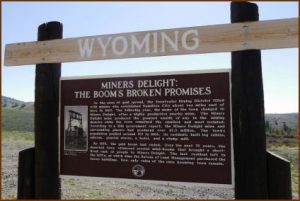
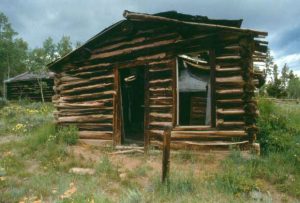 Today, the site is located on Bureau of Land Management property. Some preservation work has been done in order to keep the few remaining buildings standing, but the site is not being restored. Miners Delight is listed on the National Register of Historic Places. The site continues to preserve several cabins, one building that was said to have been a saloon, a baker, a barn, and a couple of outhouses. They are the last remnants of a long ago era.
Today, the site is located on Bureau of Land Management property. Some preservation work has been done in order to keep the few remaining buildings standing, but the site is not being restored. Miners Delight is listed on the National Register of Historic Places. The site continues to preserve several cabins, one building that was said to have been a saloon, a baker, a barn, and a couple of outhouses. They are the last remnants of a long ago era.
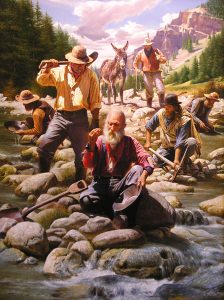 After the discovery of gold in California, people went crazy…mad really for gold. For twenty years, in fact, all the West was mad for gold. People packed up their lives, and headed west, hoping to dig their fortune out of the California dirt. At first, the people heading west were mostly men, but there were families that went too. It didn’t really matter who it was, when it came to gold, people were willing to fight to the death for what was theirs, or for what they wanted. Greed was the word of the day, and it was a disease that everyone in California had.
After the discovery of gold in California, people went crazy…mad really for gold. For twenty years, in fact, all the West was mad for gold. People packed up their lives, and headed west, hoping to dig their fortune out of the California dirt. At first, the people heading west were mostly men, but there were families that went too. It didn’t really matter who it was, when it came to gold, people were willing to fight to the death for what was theirs, or for what they wanted. Greed was the word of the day, and it was a disease that everyone in California had.
The Gold Rush brought honest citizens and outlaws alike to California. People had to be on guard at all times. If someone struck gold, they were an immediate target for anyone willing to steal their gold, or even to kill for it. The mad rush for gold soon spread to other areas of the United States. The gold-hunters, no longer content with California, began to prospect lower Oregon, upper Idaho, and Western Montana too. They figured that if one place had gold, why wouldn’t another place have it too. And with the slightest discovery, came the craziness of Gold Dust Fever.
With Gold Fever came the sinister figure of the trained desperado, the professional bad man. The business of 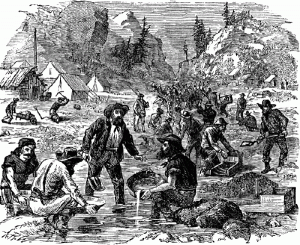 being an outlaw was turned into one highly organized profession that was relatively safe and extremely lucrative. There was wealth to be had for the asking or the taking, and these men, and sometimes women, were willing. Each miner had his buckskin purse filled with native gold. This dust was like all other dust. It could not be traced nor identified; and the old saying, ”’Twas mine, ’tis his,” might here of all places in the world most easily become true. There were no checks, drafts, or currency, as we know it now. The normal means by which civilized men keep a record of their property transactions, were unknown. The gold scales established the only currency, and each man was his own banker, obliged to be his own peace officer and the defender of his own property. It was a wild world. It was a world mad for gold.
being an outlaw was turned into one highly organized profession that was relatively safe and extremely lucrative. There was wealth to be had for the asking or the taking, and these men, and sometimes women, were willing. Each miner had his buckskin purse filled with native gold. This dust was like all other dust. It could not be traced nor identified; and the old saying, ”’Twas mine, ’tis his,” might here of all places in the world most easily become true. There were no checks, drafts, or currency, as we know it now. The normal means by which civilized men keep a record of their property transactions, were unknown. The gold scales established the only currency, and each man was his own banker, obliged to be his own peace officer and the defender of his own property. It was a wild world. It was a world mad for gold.
 Anyone who has spent much time in the Black Hills has most likely seen Deadwood, and knows it to be a historic gambling town where many famous Wild West characters hung out and died. Legends like Wild Bill Hickok and Calamity Jane each left their mark. Hickok, a legendary man even in his own lifetime, was shot in the back of the head by Jack McCall, while playing poker at the No. 10 Saloon on August 2, 1876. Calamity Jane was renowned for her excellent marksmanship, as well as her preference for men’s clothing, and brash behavior.
Anyone who has spent much time in the Black Hills has most likely seen Deadwood, and knows it to be a historic gambling town where many famous Wild West characters hung out and died. Legends like Wild Bill Hickok and Calamity Jane each left their mark. Hickok, a legendary man even in his own lifetime, was shot in the back of the head by Jack McCall, while playing poker at the No. 10 Saloon on August 2, 1876. Calamity Jane was renowned for her excellent marksmanship, as well as her preference for men’s clothing, and brash behavior.
Deadwood also had, in addition to its tough individuals, others such as Reverend Henry W. Smith. Preacher Smith was the first Methodist minister to come to the Black Hills. Smith was mysteriously murdered on Sunday, August 20, 1876, while walking to Crook City to deliver a sermon. These individuals are just a few of the many notables buried in Mount Moriah Cemetary, which was established in 1877 or 1878.
That’s all well known to many people, but some may not know that the settlement of Deadwood began illegally in the 1870s on land which had been granted to the Native Americans. In 1874, Colonel George Armstrong Custer led an expedition into the Black Hills and announced the discovery of gold on French Creek near what is now Custer, South Dakota. That announcement ushered in the Black Hills Gold Rush and gave rise to the new and lawless town of Deadwood. In 1875, a miner named John Pearson found gold in a narrow canyon in the Northern Black Hills. This canyon became known as “Deadwood Gulch,” because of the many dead trees that lined the canyon walls at that time. The name stuck. Try as they might, the government couldn’t keep the situation under wraps, in order to honor the 1868 Treaty of Fort Laramie, which forever ceded the Black Hills to the Lakota-Sioux. The government dispatched several military units to forts in the surrounding area to keep people from entering the Hills. However, people illegally entered the area anyway, searching for gold or adventure. Despite the efforts of the military and federal government. They were driven by dreams and greed.
Once Deadwood was established, the mining camp was quickly swarming with thousands of prospectors searching for an easy way to get rich. Fred and Moses Manuel, claimed the Homestake Mine, which proved to be the most profitable in the area. Although the Manuels had been lucky, others were not so fortunate. Most of the early population was in Deadwood to mine for gold, but the lawless town naturally attracted a crowd of rough and shady characters too. These particular individuals made the early days of Deadwood rough and wild. 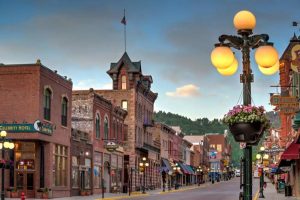 A mostly male population eagerly patronized the many saloons, gambling establishments, dance halls, and brothels. These establishments were considered legitimate businesses and were well known throughout the area.
A mostly male population eagerly patronized the many saloons, gambling establishments, dance halls, and brothels. These establishments were considered legitimate businesses and were well known throughout the area.
In 1890, the railroad connected the town to the outside world. Illegal beginnings aside, Deadwood was a town that was now here to stay. The treaty with the Lakota-Sioux was broken and the Black Hills would never again belong to them. As unfair as it was to break the treaty, I don’t think that it could have lasted forever anyway, because the United Stated was going to be populated from coast to coast one way or the other.
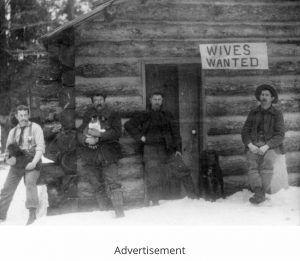 Most of us have either seen or heard of the television show called “The Bachelor.” The show is all about a single man in search of a bride. Of course, these days there are many ways to find the girl of his dreams, and most men would never go on television and let some reality show match him up with ten women for him to choose from. Of course, the idea of online dating sites is new and for some of us, still shocking too.
Most of us have either seen or heard of the television show called “The Bachelor.” The show is all about a single man in search of a bride. Of course, these days there are many ways to find the girl of his dreams, and most men would never go on television and let some reality show match him up with ten women for him to choose from. Of course, the idea of online dating sites is new and for some of us, still shocking too.
Many years ago, in the old west…especially during the gold rush days, the men in the west found themselves lonely…very lonely. They didn’t want to go back east, and few good women came to the west in those early days. Those were desperate times in the emotional lives of the gold rushers. The west was wild and unsettled, and even into the 1900s short on eligible women to marry.
There were no computers or smart phones then, and no dating apps or websites. So in an effort to find a wife, several eligible bachelors would stand in front of a log cabin, spiffed up as much as they could be, I suppose, many with beards, trying to let ok like a great catch. The photograph was then placed as an advertisement in papers back east. Personally, I don’t know if I would have been very inclined to jump on a train and head west to meet up with a man who was looking for a wife. Mail-order brides, sort of. These men would still have to woo the women, win them over, because these women weren’t slaves, and they weren’t required to stay. These bachelors would have to “sell” themselves and their lifestyle to these women, along with making the women fall in love with them.
I wondered, what kind of woman would answer such an ad. I don’t mean a loose woman, but likely a woman  who was a little bit past the normal marrying age of that time. An eighteen year old girl would never be the one to go. Her parents would likely never let her, but s woman who was in her mid-twenties would be viewed as a spinster, usually a school teacher, so she could take care of herself. She could tell her family that she was taking a job in the west. I’m sure they would be upset, but it would be her choice. And her family would have known it. Some women had no one, so there might be nothing to stop them. Still, going into the unknown like that would be scary. I don’t know how many of these men successfully found wives this way, but I suppose that if even a few did, it would be a successful bachelor show…of the time, anyway.
who was a little bit past the normal marrying age of that time. An eighteen year old girl would never be the one to go. Her parents would likely never let her, but s woman who was in her mid-twenties would be viewed as a spinster, usually a school teacher, so she could take care of herself. She could tell her family that she was taking a job in the west. I’m sure they would be upset, but it would be her choice. And her family would have known it. Some women had no one, so there might be nothing to stop them. Still, going into the unknown like that would be scary. I don’t know how many of these men successfully found wives this way, but I suppose that if even a few did, it would be a successful bachelor show…of the time, anyway.
 When we think of the Old West, the Pioneer movement, the Gold Rush, and generally, the settling of the United States, our minds immediately go to the brave men who fought the Indians, ran the wagon trains, weathered the harsh winters looking for their fortunes, and fought in the wars to make this a free nation, but seldom do we think of the anonymous heroes of that time…the women. There is a saying, “Behind every great man there’s a great woman.” that saying is one reference to the many women who have set aside their own comforts to support their man in the goals and dreams he has. In many ways that saying is the picture of the Pioneer woman, but it actually leaves something out. Just because her man did not become famous, doesn’t mean that the woman was any less behind him, supporting him in all he did.
When we think of the Old West, the Pioneer movement, the Gold Rush, and generally, the settling of the United States, our minds immediately go to the brave men who fought the Indians, ran the wagon trains, weathered the harsh winters looking for their fortunes, and fought in the wars to make this a free nation, but seldom do we think of the anonymous heroes of that time…the women. There is a saying, “Behind every great man there’s a great woman.” that saying is one reference to the many women who have set aside their own comforts to support their man in the goals and dreams he has. In many ways that saying is the picture of the Pioneer woman, but it actually leaves something out. Just because her man did not become famous, doesn’t mean that the woman was any less behind him, supporting him in all he did.
Pioneer women were there, on the home front, working hard all day trying to keep their house clean in a rugged windswept frontier. Her floors were often made of dirt, and yet she swept them. The water came from a well, or a nearby creek, and she had to haul it into the house, because her man was off hunting to bring in food for the family. The house was crudely constructed with logs and often had a sod roof, and she was right there working like a man beside her husband to get that house built. She watched over the children, and kept them safe from the many perils that were a daily encounter. From snakes, to bears, to mountain lions, to Indians, she did what she needed to, even to the point of handling a gun as well as her husband did. And yet, history looked at her as the weaker part of the partnership, the one who needed to be sheltered and protected. History looked at her as if she could not 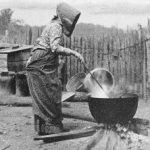 even bear to hear about certain things, because they might be too upsetting to her. In reality, they had vastly underestimated their women.
even bear to hear about certain things, because they might be too upsetting to her. In reality, they had vastly underestimated their women.
When the men got hurt, and the garden needed to be cared for, the women would till the ground…fighting with the tiller behind a horse, and winning the battle. These women took care of the house, the children, the sick or injured husband, and the garden or other crops, all without batting an eye. These women knew all about the hardships of frontier living, and when the going got tough, they didn’t turn and run back east. When the Indians attacked, they stayed and fought with their men. They could not afford to hide in a cellar, their hands were needed to hold a gun. They even faced the Indians alone, when their men were away, becoming excellent negotiators, who were able to make a trade of their wares that, in the end saved their own lives and the lives of their families. They were determined to make this new frontier work, and for the most part, they did it all without making a name for themselves. Sometimes, when we look up ancestors in historic archives, these women are either listed only as Mrs, acknowledging only the husband’s name, or they were listed only as the wife of their husband. Their true identity sometimes remains forever a mystery, and yet, they were heroes…but, they were anonymous heroes. The great men they stood behind, thereby making these men successful, may have been heroes of the frontier, and their name may have been one that every history book told us all about, 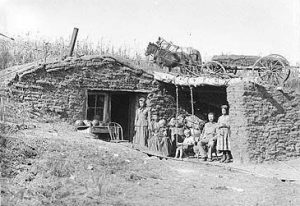 but their wives, who worked quietly beside them, remained unknown. We knew about the exploits of the men, the towns they founded, the travels they made exploring ever westward, but the women who were there with them, cooking the meals while the men talked, cleaning up afterward alone, delivering their babies often with only the help of their husband, carrying a baby, while weeding a garden, and feeding their family before themselves, going hungry, if necessary, to make sure the family was taken care of…these women rarely made the history books. Their job must have seemed to mundane to be considered adventurous, but without their contribution, this nation would not have become the great Republic that it is.
but their wives, who worked quietly beside them, remained unknown. We knew about the exploits of the men, the towns they founded, the travels they made exploring ever westward, but the women who were there with them, cooking the meals while the men talked, cleaning up afterward alone, delivering their babies often with only the help of their husband, carrying a baby, while weeding a garden, and feeding their family before themselves, going hungry, if necessary, to make sure the family was taken care of…these women rarely made the history books. Their job must have seemed to mundane to be considered adventurous, but without their contribution, this nation would not have become the great Republic that it is.

 The other day I watched a documentary about the Yukon Gold Rush. Each prospector was required by the Canadian authorities, to bring a year’s supply of food in order to prevent starvation. In all, their equipment weighed close to a ton, which for most had to be carried in stages by themselves. Together with mountainous terrain and cold climate, this meant that those who persisted did not arrive until summer 1898. It wasn’t that the border patrol was being difficult, but rather that they knew that if these prospectors were to survive the extreme weather of the Yukon Territory, they were going to need every bit of those supplies, and sometimes more. It is estimated that 100,000 prospectors who headed north to the Yukon Territory between 1897 and 1898. Of those 100,000, it is estimated that 30,000 to 40,000 actually arrived in the gold fields, and of those who actually reached Dawson City during the gold rush, only around 15,000 to 20,000 finally became prospectors. The odd were certainly stacked against them.
The other day I watched a documentary about the Yukon Gold Rush. Each prospector was required by the Canadian authorities, to bring a year’s supply of food in order to prevent starvation. In all, their equipment weighed close to a ton, which for most had to be carried in stages by themselves. Together with mountainous terrain and cold climate, this meant that those who persisted did not arrive until summer 1898. It wasn’t that the border patrol was being difficult, but rather that they knew that if these prospectors were to survive the extreme weather of the Yukon Territory, they were going to need every bit of those supplies, and sometimes more. It is estimated that 100,000 prospectors who headed north to the Yukon Territory between 1897 and 1898. Of those 100,000, it is estimated that 30,000 to 40,000 actually arrived in the gold fields, and of those who actually reached Dawson City during the gold rush, only around 15,000 to 20,000 finally became prospectors. The odd were certainly stacked against them.
On man, in particular, was of interest to me. His name was Albert J Goddard. Goddard was an American politician in the state of Washington. He served in the Washington House of Representatives from 1895 to 1897, but he also made the gold rush run during the stampede years. He had a very unique way of doing this, however. Goddard built a sternwheeler-utility boat, for use in the Yukon gold rush. The boat was named for him…the A. J. Goddard. What really interested me was that Goddard made several trips north with parts for the boat. The border patrol basically looked at him as if he was crazy. His load was extremely heavy, and they were certain that he would not make it. Nevertheless, when he got to the headwater lakes, he proceeded to put together his boat. Many of the people who met there to build their boats, were very inexperienced in boat building, and consequently, many of the boats didn’t fare well. The A. J. Goddard was the exception to the rule. Albert Goddard was the exception. He knew what he was doing, and his ship was a good one for all the years he used it. For Albert, the gold rush was not about prospecting for gold. I don’t know if he instinctively knew 
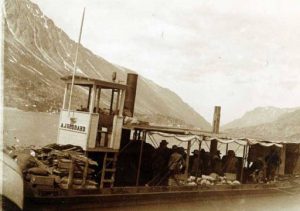 that very few people would be successful or not, but his plan was to be a transport boat to bring other prospectors to the gold fields. The A. J. Goddard made one trip to Dawson during the gold rush, was sold, and sank in a storm on Lake Laberge in 1901. I guess Goddard go out just in time, or maybe the endeavor was just not what he had in mind. The boat was rediscovered largely intact in 2008. On board the boat were artifacts of the period such as a gramophone with ontemporary recordings.
that very few people would be successful or not, but his plan was to be a transport boat to bring other prospectors to the gold fields. The A. J. Goddard made one trip to Dawson during the gold rush, was sold, and sank in a storm on Lake Laberge in 1901. I guess Goddard go out just in time, or maybe the endeavor was just not what he had in mind. The boat was rediscovered largely intact in 2008. On board the boat were artifacts of the period such as a gramophone with ontemporary recordings.
 The discovery of gold in the United States triggered massive growth, with towns springing up across the area. Helena, Montana was one of those towns. On October 30, 1864, four miners struck it rich at their appropriately named mine, “Last Chance Gulch.” From that discovery came one of the wealthiest cities in the United States by the late nineteenth century…Helena, Montana. While it was once one of the wealthiest cities, the current population of Helena doesn’t really fall in line with the direction the city appeared to be taking in 1864. As of the 2010 census the population is 28,190, making it the fifth least populous state capital in the U.S after Montpelier, Vermont; Pierre, South Dakota; Augusta, Maine; and Frankfort, Kentucky.
The discovery of gold in the United States triggered massive growth, with towns springing up across the area. Helena, Montana was one of those towns. On October 30, 1864, four miners struck it rich at their appropriately named mine, “Last Chance Gulch.” From that discovery came one of the wealthiest cities in the United States by the late nineteenth century…Helena, Montana. While it was once one of the wealthiest cities, the current population of Helena doesn’t really fall in line with the direction the city appeared to be taking in 1864. As of the 2010 census the population is 28,190, making it the fifth least populous state capital in the U.S after Montpelier, Vermont; Pierre, South Dakota; Augusta, Maine; and Frankfort, Kentucky.
My husband, Bob Schulenberg’s aunt, Marion Kanta, and her family lived in Helena until the time for her passing in 1999, and many of her family members live there still. That said, we visited the capitol city a few times, and found it to be a very nice place. Of course, during the gold rush years, things might have been very 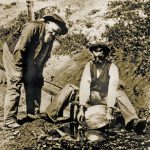 different. A gold rush town can have a tendency to be a high crime area, and when 3.6 billion dollars worth of gold is extracted in the city limits of a town over a twenty year period, you know that there were people who would like nothing more than to take over the claim of another person, no matter what it took. The first major Anglo settlement of Montana began in the summer of 1862, when prospectors found a sizeable deposit of placer gold at Grasshopper Creek to the west of what is today…Helena, Montana. When other even richer deposits were discovered nearby, a major rush began as tens of thousands of miners scoured the territory in search of gold. In 1864, four prospectors spotted signs of gold in the Helena area while on their way to the Kootenai country, but they were eager to reach the reportedly rich gold regions farther to the north and did not stop. Then, after striking out on the Kootenai, they decided to take “one last chance” on finding gold and returned. When the signs turned out to mark a rich deposit of placer gold, they staked their claims and named the new mining district Last Chance Gulch.
different. A gold rush town can have a tendency to be a high crime area, and when 3.6 billion dollars worth of gold is extracted in the city limits of a town over a twenty year period, you know that there were people who would like nothing more than to take over the claim of another person, no matter what it took. The first major Anglo settlement of Montana began in the summer of 1862, when prospectors found a sizeable deposit of placer gold at Grasshopper Creek to the west of what is today…Helena, Montana. When other even richer deposits were discovered nearby, a major rush began as tens of thousands of miners scoured the territory in search of gold. In 1864, four prospectors spotted signs of gold in the Helena area while on their way to the Kootenai country, but they were eager to reach the reportedly rich gold regions farther to the north and did not stop. Then, after striking out on the Kootenai, they decided to take “one last chance” on finding gold and returned. When the signs turned out to mark a rich deposit of placer gold, they staked their claims and named the new mining district Last Chance Gulch.
Last Chance Gulch would prove to be the second biggest placer gold deposit in Montana, producing some 19 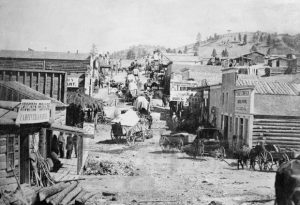 million dollars worth of gold in just four years. Almost overnight, thousands of miners flooded into the region, and the four original miners added to their fortunes by establishing the town of Helena to provide the new miners with food, lodging, and supplies. But unlike many of the early Montana mining towns, Helena did not disappear once the gold gave out, which was inevitable. Helena was able to survive and grow by serving the wider Montana mining industry, because it was located on several major transportation routes, well supplied with agricultural products from an adjacent valley, and near to several other important mining towns. In 1875, the city became the capital of Montana Territory, and in 1894, the capital of the new state of Montana.
million dollars worth of gold in just four years. Almost overnight, thousands of miners flooded into the region, and the four original miners added to their fortunes by establishing the town of Helena to provide the new miners with food, lodging, and supplies. But unlike many of the early Montana mining towns, Helena did not disappear once the gold gave out, which was inevitable. Helena was able to survive and grow by serving the wider Montana mining industry, because it was located on several major transportation routes, well supplied with agricultural products from an adjacent valley, and near to several other important mining towns. In 1875, the city became the capital of Montana Territory, and in 1894, the capital of the new state of Montana.
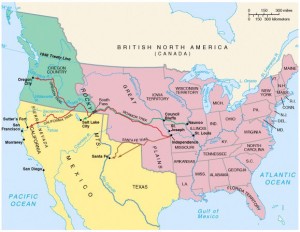 When most of us think of the pioneers traveling to the West, we think of the Gold Rush, but that was not the original reason the pioneers left the East. The East had become crowded. The availability of farm land was very scarce, and soon the crowded conditions became unbearable for many people. The West offered wide open spaces, farm land, and new scenery. It was the perfect solution for the city cramped, lovers of the wide open spaces. The biggest problem with the move West was the land disputes that existed. The British wanted to claim the land because they had reached it by sea, but Lewis and Clark were the first to make a land crossing. Russia and Spain had tried to claim ownership, but that fight was settled by treaty. Still the battle for Oregon remained for a time, between Great Britain and the United States of America. Of course, in the end the United States would win in that battle, as they had for their freedom from Great Britain years before. This land would belong to the United States of America, from Texas to Canada, and Maine to California.
When most of us think of the pioneers traveling to the West, we think of the Gold Rush, but that was not the original reason the pioneers left the East. The East had become crowded. The availability of farm land was very scarce, and soon the crowded conditions became unbearable for many people. The West offered wide open spaces, farm land, and new scenery. It was the perfect solution for the city cramped, lovers of the wide open spaces. The biggest problem with the move West was the land disputes that existed. The British wanted to claim the land because they had reached it by sea, but Lewis and Clark were the first to make a land crossing. Russia and Spain had tried to claim ownership, but that fight was settled by treaty. Still the battle for Oregon remained for a time, between Great Britain and the United States of America. Of course, in the end the United States would win in that battle, as they had for their freedom from Great Britain years before. This land would belong to the United States of America, from Texas to Canada, and Maine to California.
The Oregon trail was used for eight decades as the  natural corridor between east and west during the 1800s. The trail runs approximately 2,000 miles from Independence, Missouri to Oregon City, Oregon. It also sports spur trails to Salt Lake City, which was used when the Mormon people began moving there to escape what they felt was religious persecution, and to California, which kicked off during the gold rush. Originally, however, the Oregon Trail was a series of unconnected trails used by the Indians. The Fur Traders expanded the route for the purpose of transporting pelts to trading ports and rendezvous, but the main usage of the Oregon Trail came when a series of economic and political events converged in the 1840s to start a large scale migration west. And oddly, it had nothing to do with gold.
natural corridor between east and west during the 1800s. The trail runs approximately 2,000 miles from Independence, Missouri to Oregon City, Oregon. It also sports spur trails to Salt Lake City, which was used when the Mormon people began moving there to escape what they felt was religious persecution, and to California, which kicked off during the gold rush. Originally, however, the Oregon Trail was a series of unconnected trails used by the Indians. The Fur Traders expanded the route for the purpose of transporting pelts to trading ports and rendezvous, but the main usage of the Oregon Trail came when a series of economic and political events converged in the 1840s to start a large scale migration west. And oddly, it had nothing to do with gold.
As my sisters and I were going through our parents’ things this past weekend, we came across a book about the Oregon Trail. It brought back so many memories of our family vacations, and just how excited Dad and Mom got about seeing an Oregon Trail marker. I ended up with the book, and as I was looking through it, the memories continued to flow, but what was missing was the reason the pioneers went to Oregon in the first place. I’m not sure why I didn’t know exactly, because I’m sure my Dad would 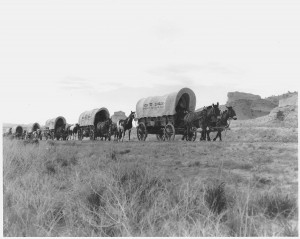 have told us, and I’m equally sure that it was in my history books. Of course, both of those sources would have required me to listen to them, and history was not really of interest to me then…ironic isn’t it? Nevertheless, the good news is that it is never to late to learn, and this week I learned something new about all those Oregon Trail monuments Dad and Mom took us to, and the significance they had on this nation…and even my own life. The ruts I’ve seen mean more to me now, and maybe I’ll have to go see them again, and if I get real ambitious, maybe Bob and I will have a new trail to think about conquering. I wonder what he will say about that idea.
have told us, and I’m equally sure that it was in my history books. Of course, both of those sources would have required me to listen to them, and history was not really of interest to me then…ironic isn’t it? Nevertheless, the good news is that it is never to late to learn, and this week I learned something new about all those Oregon Trail monuments Dad and Mom took us to, and the significance they had on this nation…and even my own life. The ruts I’ve seen mean more to me now, and maybe I’ll have to go see them again, and if I get real ambitious, maybe Bob and I will have a new trail to think about conquering. I wonder what he will say about that idea.

